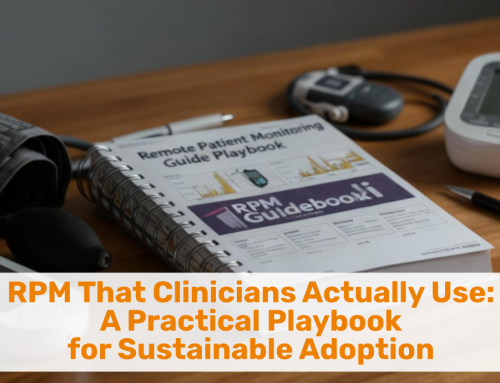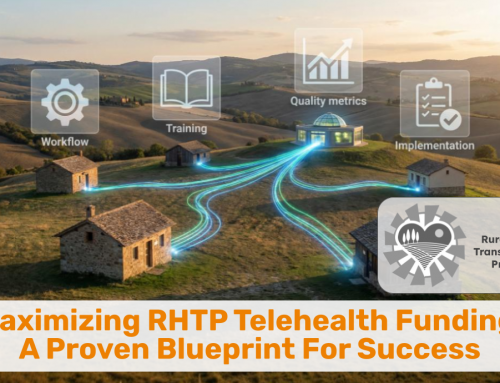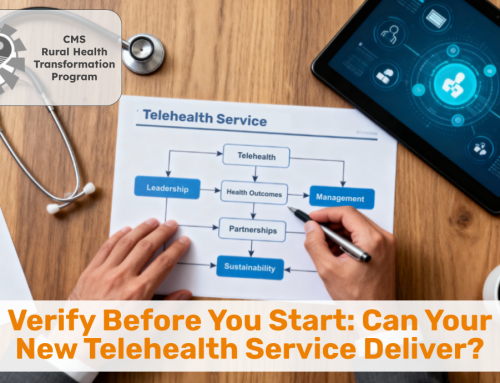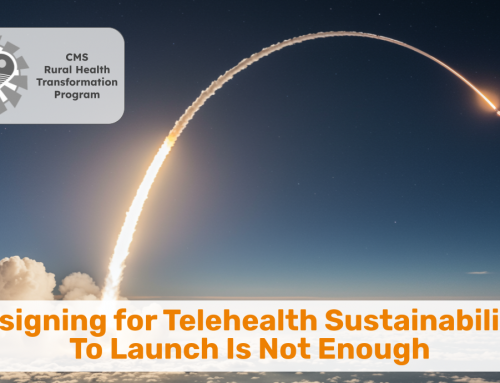Telehealth has proven its value across a wide spectrum of care, but persistent barriers are keeping patients from taking full advantage of all that telehealth has to offer. Despite increasing adoption and broader acceptance of virtual care by many care providers, many patients still face obstacles that prevent them from fully participating in telehealth services.
Drawing from the work with our clients in predominantly rural areas and the insights I shared during a recent Wyoming Telehealth Network (WyTN) webinar on “Overcoming Common Barriers to Telehealth”, three common themes of patient-related barriers to telehealth stand out:
-
Access
-
Digital Literacy
-
Care Engagement
Each of these barriers affects a different part of the patient journey and requires distinct, targeted solutions. Below, we examine these challenges in more detail and share proven solutions that organizations and communities are using to overcome those barriers.
Overcoming “Access” as a Barrier to Telehealth
In an ideal world, patients would be able to access virtual care from the comfort of their home — but for some single parents or a senior in a rural community with just a simple phone and a limited data plan, even the most basic access to care can be out of reach. Even in 2025, many patients still encounter barriers that center around transportation, technology, time, and money.
-
Transportation: long distances to care facilities (especially specialty care), lack of public or personal transportation, or simply money for gas or public transport.
-
Technology: no devices, no connectivity, or no money for data plans.
-
Time: having a job with no paid time off (or risk of losing job when taking time off), working multiple jobs, or no money for daycare.
Almost by definition, a virtual visit is shorter as it does not require travel time or time in the waiting room. Here are a number of solutions that can help to shorten distances (which saves time) or make technologies available.
1. Rural Clinics: Rural clinic sites, the most common origination points for Telehealth pre-Covid, can provide ready access to virtual specialty care services, including pre- and post-surgical services or even behavioral health, or substance use disorder treatment. For over 10 years, that type of telehealth service was what I predominantly was engaged to help health systems to launch.
2. Intermittent Clinics: When it’s not feasible to have a clinic open 5 days a week or when there is simply no way to have a clinician at the clinic, locations that are open and staffed even just for a few half days a week can overcome the transportation and technology barriers. By using an RN or an MA as the “telepresenter” these remote locations can be used for scheduled or ad hoc video visits with clinicians in the main office. Whether you are using abandoned store fronts, EMS stations, or co-locate with other service providers: keeping care local and virtual combines the best of both worlds.
3. Mobile Clinics: Quite a few of our clients have had an opportunity to acquire a mobile clinic and when these are managed (and promoted) well, they can provide another great lifeline to residents in town that no longer have a doctor. Mobile clinics can offer screening or lab testing — but they can also be used to “host” video visits with clinicians back at the main clinic — or even specialists at a larger health system many miles away.
4. Public Telehealth Access Points: In a more and more digitally connected world, these community infrastructure investments in Community Centers and Public Libraries can provide community members a private, safe place to have a video visit — and oftentimes some digital support is readily available, too. The NRTRC maintains a map of known Telehealth Access Points.



Overcoming “Digital Literacy” as a Barrier to Telehealth
Even when patients have access to virtual care, they may lack the confidence or skills to successfully complete a telehealth visit. While telehealth can be as easy as clicking on a link in a text message, different video visit solutions require different levels of technical sophistication.
Under the pressure of cost cutting measures many healthcare IT departments have pushed out telehealth-optimized stand-alone solutions in favor of (oftentimes dismally implemented) video visit functionality bolted onto the EHR in the wake of COVID. While these solutions are supposedly integrated, their feature set is limited and the patient experience is oftentimes harrowing (when was the last time a CIO interviewed patients what they wanted?). But I digress.
Here are a few common “digital literacy” challenges that some patients experience as a digital patient:
-
Email: Creating and managing an email account – most people use texting or some other form of text-based communication. Yet emails are required to create patient portal accounts, receive notifications or to log into a video visit platform.
-
Patient Portals: Creating or using a patient portal account — many EHR-embedded video visit solutions use the portal as a way to connect the patient to the video room. But navigating the oftentimes cumbersome user experience can be cumbersome and overwhelming for digital novices.
-
Installing Apps: Surprisingly even the concept of going to an AppStore to install an app (or even to scan a QR code) can be an alien concept to those who use their phones to make calls, send text messages, and take photos. If your video solution requires an App, more thought is needed to provide digital equity.
-
Technical Troubleshooting: The most frustrating experience about telehealth in the beginning of COVID was patients (and clinicians) inability to quickly troubleshoot and solve sound, video, or connectivity issues. Over time, embedded self-test tools helped to address this problem, but oftentimes those that know how to do a self-test also know how to troubleshoot…
Here are some of the solutions to overcome digital literacy barriers that hinder access to care via telehealth.
6. User-Friendly Video Visit Platform: That is oftentimes the most obvious but also the most overlooked solution. Through years of “training”, clinicians have learned to just “suck it up” when technology stands in the way of delivering great patient care and patients rarely have an opportunity to voice their frustration – and many not-so-literate patients will first blame themselves, thinking that everyone else has it figured out. So leadership and IT are clueless as to the pain they are causing patients and clinicians.
7. In-Clinic Tech Assistance: The best of the best have a designated process that helps patients after an in-person visit to get set up for their telehealth visit (or gain access to their patient portal account). Your friendly front-office staff with a high affinity for technology? They are your best “digital health ambassador” to set up patients powerfully for the digital age.
8. Telehealth TechChecks: In the early hours of Covid-19 health crisis I quickly realized that the hundreds of patients that would be experiencing their first telehealth visit had no clue how to make that work in all its nuances — and that it would be the clinicians who’d be frustrated and irritated by having their job description amended with “provides patients with video visit tech support on Android and iOS phones”. A Telehealth TechCheck is ideally conducted with the patient 1-2 days before their first video visit to ensure that the technology works (for them) and that they know what to expect.
9. Community-Based Digital Navigators: If your clinic staff cannot provide either of the previously mentioned services, you can team up with “digital navigators”, home health staff, community health workers, or community paramedics to provide the tech coaching to patients.
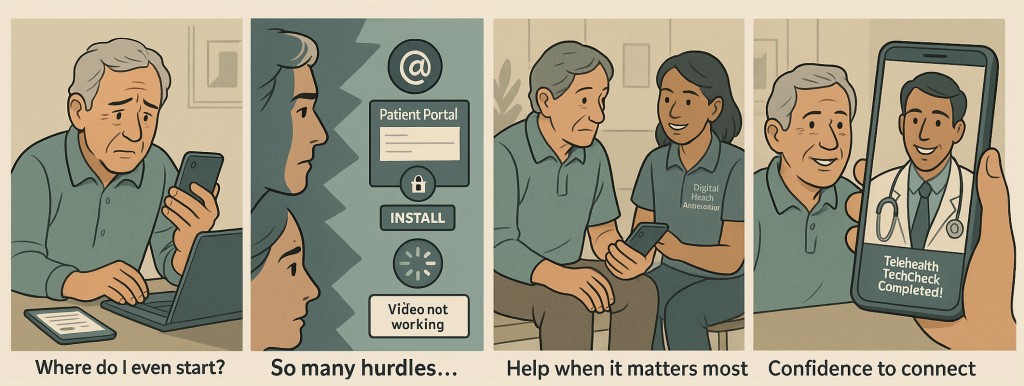


Overcoming “Patient Engagement” as a Barrier to Telehealth
When patients are not engaged in their care, they don’t take their medication, don’t follow the exercises, miss tests and appointments. For patients with chronic or acute conditions, the outcomes can be expensive and scary at best or devastating or even fatal at worst. As humans we are sometimes our worst enemy.
In my view of the world “every system is perfectly designed to get the results it gets”. As leaders and therefore change agents we thus need to take it upon ourselves to change the system – so clinicians and staff can motivate and empower patients to be “in charge” of their health. Continuity of care, coordination of care, and access to accurate, complete information are paramount to clinicians’ abilities to deliver extraordinary care. And lack of patient engagement makes this very difficult to do.
Here are some of the key challenges related to the lack of patient engagement:
-
Missed appointments (no-shows) and last-minute cancellations
-
Poor adherence to care plans
-
Communication mismatches – language and literacy
Here are a few ways to use telehealth to increase patient engagement:
10. Cancellation and No-Show Conversions: Oftentimes the reason for cancellation of (in-person) visits is the lack of time required for a visit. When patients call to cancel or are not checked in 5 minutes after their appointment time, patient service reps can offer a video visit in lieu of the in person visit, thus maintaining continuity of care that can increase patient engagement.
11. Telehealth as a Tool for Continuity: The best way to increase engagement is to stay in regular touch with the patient. Beyond video visits as less logistically challenging alternative to in-person visits, an enrollment in an RPM (Remote Physiological Monitoring) service to manage a chronic condition, or the integration of a secure messaging solution will provide multiple communication channels to keep letting the patient know that their care team cares about their health.
12. Integrated TeleInterpretation Services: Just 10 years ago only the largest health system could afford to have in-person medical translators. Over time, phone-based medical interpreters became available, but communication was often hard over a “speaker phone”. In the next innovation wave, mobile, tablet-based interpreter solutions offered a video connection which improved communication during in-person visits, but also made it harder to see and hear the clinician, the patient, and family members. This last innovation iteration of video interpretation made it a natural fit with video visits – a simple 3-way call can now connect all parties in real time with great video and great audio making medical interpretation incredibly seamless.
And I’m guessing that AI-powered real-time translation that replaces the original language feed is not far behind.
Futuristic Bonus 13. AI-powered Post-Visit Virtual Chat: While not ready for prime time, a number of startups are working on AI-powered solutions that provide access to either an avatar or even a likeness of the clinician that patients can query in real-time after the visit. And the responses can be tailored to the appropriate literacy level (and preferred language), while using the actual visit conversation and the medical record as the basis for the conversation.
Telehealth is the Future
Access to healthcare is by many (and the World Health Organization) considered to be a human right; and while some fear that the technology advancements will leave some people behind, these 12 solutions I described above to overcome the three most common types of barriers should make clear that telehealth is a tool that will greatly improve health outcomes, not widen any existing gap.
Next week, we’ll shift focus to the clinician side of the equation — exploring what prevents providers from embracing telehealth and how organizations are helping them deliver confident, high-quality care at a distance.
If you’d like to optimize your telehealth service, check out these practical resources on designing, implementing, and optimizing virtual care. Or chat with me to pick my brain. Let’s connect!








To receive articles like these in your Inbox every week, you can subscribe to Christian’s Telehealth Tuesday Newsletter.
Christian Milaster and his team optimize Telehealth Services for health systems and physician practices. Christian is the Founder and President of Ingenium Digital Health Advisors where he and his expert consortium partner with healthcare leaders to enable the delivery of extraordinary care.
Contact Christian by phone or text at 657-464-3648, via email, or video chat.


